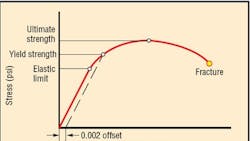Motion Design 101: Stress-strain curves
When selecting between different materials and different material grades, chemical and electrical properties may weigh on the choice, but often the mechanical behavior is tuned to the application. You can infer many of a material's mechanical properties from its stress-strain curve.
Some materials depart gradually from the linear-elastic region, and noticeable yielding might not occur until a bit past the earliest plastic portion of the curve, so the yield strength is set slightly above the elastic limit. The ultimate (tensile) strength, which is the highest point on the curve, is usually well into the plastic region for ductile metals.
While yield strength and ultimate strength refer to the stress withstood to these points, ductility is the amount of plastic deformation until fracture, so ductile materials go far along the strain axis. Ductility helps warn when a component has had it, since it often becomes obviously misshapen. Nevertheless, fatigue failure of ductile metals can occur in a brittle manner.
Energy absorption accounts for both load and deflection. Toughness is the ability to absorb energy until fracture; it is the total area under the stress-strain curve. Tough members take a lot of punishment without breaking as they plastically deform. The right mix of ductility and strength provides optimum toughness.
The resiliency of a material refers to the absorption of energy with a fully elastic recovery. Resiliency is the area under the elastic region of the stress-strain curve. Springs are an example of a component benefiting from resilient materials.
Q. How are stress-strain properties established?
A. Usually a specimen is loaded in tension and steadily elongated until it ruptures. Deflection and load are measured throughout and translated into engineering stress and strain, where original area and length are used.
Q. Does all this tensile information apply to compression? How about shear and torsion?
A. For compressed components, tension tests often supply adequate structural information, although there are definite instances where compressive tests are necessary, such as when a material is brittle under tension. Shear and torsion fall along different lines than tension and compression, and tests using shear and torsional loading are not uncommon.
Q. Is elastic behavior always described by a straight line?
A. No. There are engineering materials, such as concrete, that exhibit nonlinear elastic behavior, and the traditional modulus of elasticity (the slope of the line) does not apply; a secant or tangent modulus is used instead.
